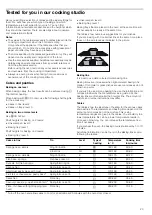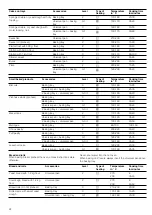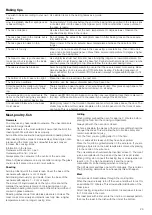
30
Preserving
For preserving, the jars and rubber seals must be clean and
intact. If possible, use jars of the same size. The information in
the table is for round, one-litre jars.
Caution!
Do not use jars that are larger or taller than this. The lids could
crack.
Only use fruit and vegetables in good condition. Wash them
thoroughly.
The times given in the tables are a guide only. The time will
depend on the room temperature, number of jars, and the
quantity and temperature of the contents. Before you switch off
the appliance or change the cooking mode, check whether the
contents of the jars are bubbling as they should.
Preparation
1.
Fill the jars, but not to the top.
2.
Wipe the rims of the jars, as they must be clean.
3.
Place a damp rubber seal and a lid on each jar.
4.
Seal the jars with the clips.
Place no more than six jars in the cooking compartment.
Making settings
1.
Insert the universal pan at level 2. Arrange the jars on it so
that they do not touch each other.
2.
Pour ½ litre of hot water (approx. 80 °C) into the universal
pan.
3.
Close the oven door.
4.
Set
$
Bottom heating.
5.
Set the temperature to between 170 and 180 °C.
Preserving
Fruit
After approx. 40 to 50 minutes, small bubbles begin to form at
short intervals. Switch off the oven.
After 25 to 35 minutes of residual heat, remove the preserving
jars from the cooking compartment. If they are allowed to cool
for longer in the cooking compartment, germs could multiply,
promoting acidification of the preserved fruit.
Vegetables
As soon as bubbles begin to form in the jars, set the
temperature back to between 120 and 140 °C. Depending on
the type of vegetable, heat for approx. 35 to 70 minutes. Switch
off the oven after this time and use the residual heat.
Taking out the jars
After preserving, remove the jars from the cooking
compartment.
Caution!
Do not place the hot jars on a cold or wet surface. They could
suddenly burst.
Acrylamide in foodstuffs
Acrylamide is mainly produced in grain and potato products
prepared at high temperatures, such as potato crisps, chips,
toast, bread rolls, bread or fine baked goods (biscuits,
gingerbread, cookies).
Fruit in one-litre jars
When it starts to bubble
Residual heat
Apples, redcurrants, strawberries
Switch off
approx. 25 minutes
Cherries, apricots, peaches, gooseberries
Switch off
approx. 30 minutes
Apple purée, pears, plums
Switch off
approx. 35 minutes
Vegetables with cold cooking water in one-litre jars
When it starts to bubble
Residual heat
Gherkins
-
approx. 35 minutes
Beetroot
approx. 35 minutes
approx. 30 minutes
Brussels sprouts
approx. 45 minutes
approx. 30 minutes
Beans, kohlrabi, red cabbage
approx. 60 minutes
approx. 30 minutes
Peas
approx. 70 minutes
approx. 30 minutes
Tips for keeping acrylamide to a minimum when preparing food
General
■
Keep cooking times to a minimum.
■
Cook meals until they are golden brown, but not too dark.
■
Large, thick pieces of food contain less acrylamide.
Baking
With top/bottom heating max. 200 °C.
With 3D hot air or hot air max.180 °C.
Biscuits
With top/bottom heating max. 190 °C.
With 3D hot air or hot air max. 170 °C.
Egg or egg yolk reduces the production of acrylamide.
Oven chips
Spread evenly over the baking tray, in a single layer. Bake at least 400 g per baking tray
so that the chips do not dry out
Содержание HGD745225N
Страница 1: ... en Instruction manual 3 nl Gebruiksaanwijzing 32 Free standing cooker Fornuis HGD745225N ...
Страница 2: ...2 Ø cm ...
Страница 62: ......
Страница 63: ......
















































